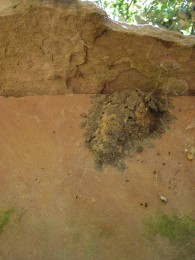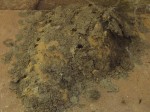Garden Log:
1) Rough day garden-wise, for me. No time spent in the garden today.
You, the Habitat Gardener:
1) No time spent in the garden today for you either, eh? Well, then, we’ll dig deep to find us a silver lining in not getting out there. In fact, it seems to me that we could give ourselves credit for not disturbing the earth, the soil, the fabric of Life that teems well without our intervention. Bare soil left bare for microbes, mollusks, insects, and larger critters. That garden life will use exposed soil to navigate through and on, to shelter in, to make shelter with (like a mud wasp might collect mud to create a nest nearby), to eat (as an earthworm processes the soil for the food in it), and to bathe in (like a bird might take a dust bathe to rid itself of tiny critters). The soil, the “weeds”, the debris piles are just there and they will do fine as we take our break from the garden or otherwise do not get to it. The fullness of Life in the garden won’t skip a beat if we don’t get out to it. My message is: Relax. Allow what you don’t do to be a part of your habitat gardening Master Plan.
Frederique Lavoipierre, Entomology Program Coordinator, of Sonoma State University’s School of Science and Technology, offers this regarding the fragile chaparral ecosystem that is often “improved upon” by gardeners:
“Introducing “more structural diversity with meadows, and trees and different canopies”, and increasing “the amount of water on the land and more soil” may increase the usefulness of the land in human terms (and may even shade out the offending [unwanted trees and plants]), but it will no longer be chaparral. Chaparral is not meant to be structurally diverse to the extent found in a permaculture garden, and increasing water, and especially adding more enriched soil, effectively destroys the fragile chaparral environment. Chaparral is a beautiful and biodiverse ecosystem that does not need improvement. It has an incredible biodiversity of insects associates and harbors many plants, reptiles and small mammals that only thrive in the somewhat poor (to us) soil of the chaparral.”
2. We have a mud wasp nest in the garden under
West County Seat, a stacking of slate for critters to live in and humans to park on. I love the local color — the orangeish soil is our yard’s adobe. I put out clobs of it on some of the wood we have in the garden. The clay keeps the wood moist longer AND wasps flock to it to gather it up and build nests with.
Nice job today, not in the garden.
Tony


